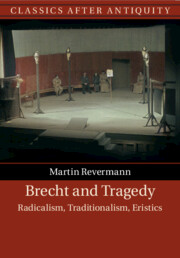Book contents
- Brecht and Tragedy
- Classics After Antiquity
- Brecht and Tragedy
- Copyright page
- Dedication
- Contents
- Figures
- Acknowledgements
- A Note on Texts and Translations
- Introduction: Radicalism, Traditionalism, Eristics
- Part I Point of Contact 1948
- 1 1948: A Year of krisis
- 2 Professing Non-Aristotelianism: Brecht’s Small Organon for the Theatre (1948)
- 3 Utilizing Greek Tragedy: Brecht’s The Antigone of Sophocles (1948)
- 4 The Making of a Model: Antigonemodell 1948
- Part II Positionings
- Part III Comparatist Explorations
- Bibliography
- Index
1 - 1948: A Year of krisis
from Part I - Point of Contact 1948
Published online by Cambridge University Press: 16 December 2021
- Brecht and Tragedy
- Classics After Antiquity
- Brecht and Tragedy
- Copyright page
- Dedication
- Contents
- Figures
- Acknowledgements
- A Note on Texts and Translations
- Introduction: Radicalism, Traditionalism, Eristics
- Part I Point of Contact 1948
- 1 1948: A Year of krisis
- 2 Professing Non-Aristotelianism: Brecht’s Small Organon for the Theatre (1948)
- 3 Utilizing Greek Tragedy: Brecht’s The Antigone of Sophocles (1948)
- 4 The Making of a Model: Antigonemodell 1948
- Part II Positionings
- Part III Comparatist Explorations
- Bibliography
- Index
Summary
This chapter discusses the autobiogrpahical background to brecht's 'greek year' 1948 in switzerland, seeing it as a year of 'krisis' (='decision').
- Type
- Chapter
- Information
- Brecht and TragedyRadicalism, Traditionalism, Eristics, pp. 43 - 50Publisher: Cambridge University PressPrint publication year: 2021



